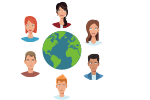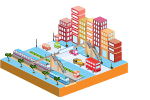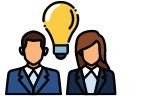The Interview | Aurélia Nguyen
 |
Could you tell us briefly what your organization does? What is your role? What is your goal? |
Put simply, Gavi, the Vaccine Alliance, is an international public-private partnership that helps vaccinate half the world’s children, protecting them from a range of deadly and devasting infectious diseases. Since we were created in 2000, and before COVID-19, we have helped protect an entire generation, vaccinating more than 888 million children and preventing more than 15 million deaths. Normally as Managing Director of Vaccines and Sustainability, I am in charge of vaccine supply and demand, as well as market-shaping, working with industry to improve equitable access to the vaccines we supply. However, since this pandemic, I have taken on a leadership role in the global response as Managing Director of the COVAX Facility, which Gavi hosts. Created in response to the COVID-19 pandemic, COVAX is a global partnership with the principle aim of making global access to COVID-19 vaccines equitable.
From the very beginning of this pandemic, it was clear that we didn’t just need vaccines, we needed vaccinations and billions of them. That meant finding a way to avoid a repeat of what happened in the last pandemic when a small number of countries bought up almost the entire global supply of swine flu vaccines, leaving little for the rest of the world, the majority of which could not afford them. COVAX was created to solve this problem. Led by Gavi, the Coalition for Epidemic Preparedness Innovations (CEPI), the World Health Organization (WHO), and UNICEF, and with the support of 193 governments, representing around 90% of the global population, COVAX was founded to ensure that the most vulnerable people are protected, regardless of their ability to pay.
COVAX works by removing financial barriers that would otherwise hinder access to COVID-19 vaccines for billions of people. It does this through a financial mechanism, called the Gavi COVAX Advance Market Commitment, or AMC, which enables us to buy in bulk, providing vaccines to people in the 92 lower-income economies paid for largely through donor funding. So far, we have delivered around 320 million doses to people in 144 economies, the majority going to people in the poorest countries, millions of people who would others struggle to get access. By the end of the year, we hope to have 1.4 billion doses available for supply and 4.4 billion through 2022.
 |
Among the concentration of actors in Geneva (OIs, NGOs, permanent missions, academia, and the private sector), who do you work with and how? |
Both Gavi and COVAX are essentially global partnerships that work because they draw on the strengths of partnerships. In addition to Gavi’s core partners, the WHO, UNICEF, the World Bank, and the Bill & Melinda Gates Foundation, Gavi relies on the expertise, resources, and infrastructure of a wide range of partners, including sovereign governments, private sector foundations, and corporate partners; NGOs, advocacy groups, professional and community associations, faith-based organizations and academia; vaccine manufacturers, including those in emerging markets; research and technical health institutes; and the governments of implementing countries.
COVAX is built on similar foundations. In addition to helping to develop and provide access to COVID-19 vaccines, COVAX draws on the strengths of its partners to ensure that all the pieces are in place to make sure they reach people, and not just the supply chain, and delivery infrastructure. This includes creating innovative solutions for historic challenges such as legal safety nets covering compensation and liability and indemnification. COVAX demonstrates that when the world works together, it is possible to mount a global response that ensures everyone can be protected.
 |
What are the strengths and weaknesses of Geneva with regards to the development of your activity? |
Even though Gavi is an international organization it is without a doubt Swiss-born and bred! It was first launched in Davos at the World Economic Forum and has been based here, in Geneva, ever since. Given that Geneva is the international capital of global health and home to the WHO and parts of UNICEF, it makes a lot of sense being here. It puts us in close proximity to some of our core partners, as well as a range of others like IFRC, IOM, and UNHCR, and this helps to build stronger relationships which is what we thrive on. As a highly innovative organization that is built on cooperation, this is what makes Gavi so effective and impactful. In fact, in the few years since we moved to the Global Health Campus, sharing our premises with the Global Fund and UNITAID, among others, has already helped to foster new and close collaborations. We’ve certainly come a long way since our humble beginnings, taking up just five desks in a small UNICEF basement office! And of course, Geneva is an incredibly multi-cultural city, which not only reflects Gavi’s make-up, but it also makes it an exciting and interesting place to live and work.
Being located centrally in Europe has its advantages, but it also means we are a long way from most of the countries we support. We are a very lean organization with just our Geneva HQ and a small satellite office in Washington DC, and therefore have no people based in the countries with work support. This can create challenges. For example, one of the downsides of living in a global village like Geneva is that its airport is relatively small. This means that if ever you need to have face-to-face interactions with in-country partners or visit programs or manufacturers, which under normal circumstances is frequently necessary, direct flights are rarely available. Since COVID-19, travel restrictions have of course made that even more difficult. And given how the pandemic and vaccine inequity have intensified the economic and health gaps between lower-income countries that Gavi and COVAX support and countries like Switzerland, it can sometimes feel like we are even further away from the issues we are trying to help with.
 |
|
My hope is that if anything positive is to come from this pandemic, it is that the world will learn important lessons that ensure we never again have to experience a global health crisis on the scale we are seeing today. The fact is, even though this pandemic clearly caught the world off-guard, many of us have been warning for years about the growing risk of pandemics, and the broader impact they can have on societies and economies. Governments and global leaders need to stop waiting until the infectious disease becomes a risk to global security before they start treating it like one. That means building on the lessons learned and strengths proven during this pandemic so we can better plan and prepare for the next one because there will be a next one. The nature of infectious diseases means that it is not a question of if another virus will emerge with pandemic potential, but when. That is an evolutionary certainty.
Today we are seeing the risks posed by infectious disease not just for global health security but for global security and stability. COVID-19 is our wake-up call. With the right support, we can mitigate much of the risk by improving people’s access to health. If people have better access to primary health care, we can improve surveillance and our response, both of which reduce the chances of escalation, and we can mitigate the impacts if escalation does occur. But that can only happen if pandemic prevention and response becomes a global priority and receives the same focus and attention as other global threats. And COVAX has shown that this can only be achieved if global leaders work together towards truly global solutions. Whatever form pandemic preparedness takes moving forwards the reality that “no-one is safe, until everyone is safe” has to be the legacy of COVID-19.
